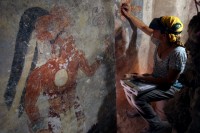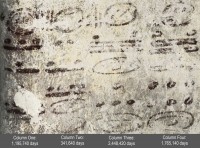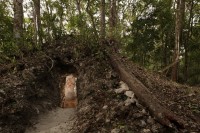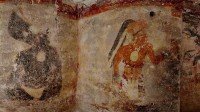 Archaeologists mapping the Classic period (200 to 900 A.D.) Maya city of Xultun in northeast Guatemala have discovered a room painted with murals including hundreds of numbers and astronomical tables that are the oldest Maya calendar calculations ever found. The calendar dates to 813 or 814 A.D., which we know so precisely because the inscribers generously dated their work. Before this discovery, the earliest calendrical calculations known to survive the bonfires of the post-Columbian missionaries were in the 11th-12th century Dresden Codex. There is enough overlap with the calendar texts in the Dresden Codex that it’s likely they both relied on earlier texts that have not survived, or at least not been found yet.
Archaeologists mapping the Classic period (200 to 900 A.D.) Maya city of Xultun in northeast Guatemala have discovered a room painted with murals including hundreds of numbers and astronomical tables that are the oldest Maya calendar calculations ever found. The calendar dates to 813 or 814 A.D., which we know so precisely because the inscribers generously dated their work. Before this discovery, the earliest calendrical calculations known to survive the bonfires of the post-Columbian missionaries were in the 11th-12th century Dresden Codex. There is enough overlap with the calendar texts in the Dresden Codex that it’s likely they both relied on earlier texts that have not survived, or at least not been found yet.
 The hieroglyphs include columns of numbers reflecting the 260-day ceremonial calendar, the 365-day solar calendar, the 584-day cycle of Venus and the 780-day cycle of Mars. Tables track the phases of the moon, and some calculations appear to be attempts to reconcile the lunar and solar calendars. In a touching link to educators 1200 years later, there are numbers painted in red that correct the calculations painted in black next to them.
The hieroglyphs include columns of numbers reflecting the 260-day ceremonial calendar, the 365-day solar calendar, the 584-day cycle of Venus and the 780-day cycle of Mars. Tables track the phases of the moon, and some calculations appear to be attempts to reconcile the lunar and solar calendars. In a touching link to educators 1200 years later, there are numbers painted in red that correct the calculations painted in black next to them.
The real headline-grabber is that the calendar counts through 17 Bak’tuns. That’s a total of 7,000 years and takes us far past our current 13th Bak’tun cycle which is scheduled to end on December 23rd of this year in the fiery apocalypse that will destroy us all. How convenient that “scholars” and “experts” who have always claimed that the Maya 2012 apocalypse notion is a ludicrous misinterpretation of Maya calendar cycles find four more cycles JUST IN THE NICK OF TIME.
 The calendar is not the only uniquely important aspect of this find. The murals are painted on the walls and ceiling of a small dwelling. It’s a room about six and a half feet wide, six feet long and 10 feet tall. This is the first time murals have been found somewhere that is not a temple or palace. Also, the room was filled in an unusual way, from the inside backing out through the doorway. Usually the Maya just flattened the roof of a building when they were done with it, and then built on top of that. The peculiar filling approach taken with this room ensured that the paintings on three of the four walls plus the ceiling were preserved.
The calendar is not the only uniquely important aspect of this find. The murals are painted on the walls and ceiling of a small dwelling. It’s a room about six and a half feet wide, six feet long and 10 feet tall. This is the first time murals have been found somewhere that is not a temple or palace. Also, the room was filled in an unusual way, from the inside backing out through the doorway. Usually the Maya just flattened the roof of a building when they were done with it, and then built on top of that. The peculiar filling approach taken with this room ensured that the paintings on three of the four walls plus the ceiling were preserved.
The archaeologists working on the site never expected that. Boston University undergraduate Maxwell Chamberlain was looking into an old looting trench during his lunch break when he saw some faded paint on the wall. BU archaeologist and team leader William Saturno figured it was worth exploring the chamber in case there was any paint left, but he assumed there’d be only traces at best so they’d just map the room and perhaps be able to figure out its dimensions at the time the murals were painted.
 Instead they pulled a Howard Carter and found an archaeological treasure trove (minus the gold). In addition to the calendar hieroglyphs on the east and north walls, they found several unusual murals. On the north wall:
Instead they pulled a Howard Carter and found an archaeological treasure trove (minus the gold). In addition to the calendar hieroglyphs on the east and north walls, they found several unusual murals. On the north wall:
An off-center niche in the wall features a painting of a seated king, wearing blue feathers. A long rod made of bone mounted on the wall allowed a curtain to be pulled across the king’s portrait, hiding it and revealing a well-preserved painting of a man whose image is wrapped around the wall; he is depicted in vibrant orange and holds a pen. Maya glyphs near his face call him “Younger Brother Obsidian,” a curious title seldom seen in Maya text. Based on other Maya sites, Saturno theorizes he could be the son or younger brother of the king and possibly the artist-scribe who lived in the house. “The portrait of the king implies a relationship between whoever lived in this space and the royal family,” Saturno said.
On the west wall:
Three male figures loom on this wall, all of them seated and painted in black, wearing only white loincloths, medallions around their necks and identical single-feathered, miter-style head dresses. “We haven’t seen uniform head dresses like that anywhere before,” Saturno said. “It’s clearly a costume of some kind.” One of the figures is particularly burly, “like a sumo wrestler,” and he is labeled “Older Brother Obsidian.” Another is labeled as a youth.
Saturno thinks the room was a writing room, a study for Maya scribes. The figure holding a pen indicates a connection to scribes and the repetition of hieroglyphs on the east wall complete with corrections in red suggests that the calculations could have been practice for later work in the formal halls of religious and political power.
The discovery has been published in the May issue of the journal Science (subscription only). There’s a fascinating interview with Saturno in the latest Science podcast.
Pictures are courtesy of National Geographic which sponsored the expedition. Their website has an awesome gigapixel zoomable image of the mural here.